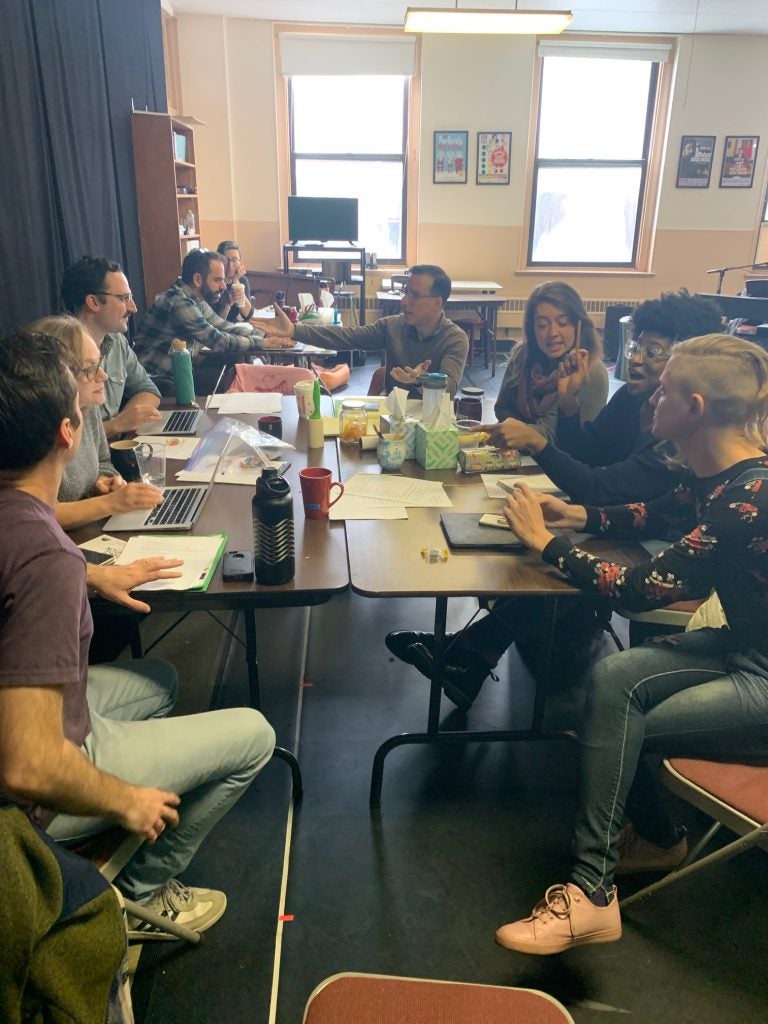Sharpening the sting for ‘This Is the Week That Is’
A reporter eavesdrops on the give-and-take in the writers’ room during prep for the stage spoof 1812 Productions has produced over the holidays for the past 14 years.

Tanaquil Márquez (left) and Brett Ashley Robinson in a skit about self-care at 'This Is the Week That Is.' (Courtesy of Mark Garvin)
Comedy is serious business inside the writers’ room of “This Is the Week That Is,” — the annual holiday-time stage spoof that 1812 Productions has produced for 14 years — a show that draws new and returning audiences with its high production values and higher standard of irreverence, a two-hour mix of shaming politicians and shilling for the stage company itself.
If you fail to laugh out loud at least a couple times when you see it, you are from a culture without a president, presidential candidates, news reports, and anything like modern Western culture.
All of those subjects are ripe for plucking at “This Is the Week That Is,” running through Jan. 5 at Plays & Players in Center City. 1812 Productions is the nation’s only professional stage company whose season is entirely devoted to comedy, probably never more so than in November and December, when the cast and staff gather to create and present this particular show.
But in the writers’ room at the 1812 Productions office, a rented space in a South Philadelphia church, it’s not all yucks. The truth is, there’s always room for skewering politicians and celebrities, but trying to mine chuckles from the news these days can be an exhausting journey to a dead end.

Jennifer Childs, the artistic leader of 1812 Productions, nodded understandingly when one of the actors ventured that we’re all increasingly plagued by “outrage exhaustion.” Later, she said, “This is fun, but hard also emotionally. You really need the group in order to find the funny.”
A writers’ room onlooker recently got to witness that firsthand.
For example: In a discussion of “the new normal” — a promising theme for a skit, and one likely to get laughs in the show — the cast and writers, a total of 10 around a table in the room — threw out ideas to see what might fly. At this particular early writing session, the results were not auspicious: “It’s the first presidential election with women running against each other!” “There’s no reprisal now for bad behavior!” “There’s no adherence to precedence!” “Subpoenas don’t mean anything!” “How about the resurgence of astrology?”
That last one was pertinent: With only two weeks to go until the first preview performance the night after Thanksgiving, the show seemed to be hidden in the stars. But everyone in the room — everyone in theater, period — knows that nothing makes the creative juices flow like the approach of opening night. Indeed, when I saw the show at its second preview, 15 days after that writers’ meeting, it was already a nicely-knitted piece. Some material would go and some would be added by the Dec. 4 opening night – audience reaction at previews is particularly relevant. Still, on this preview night, the laughter from a near-full house was cementing the script.
Advance sales, according to the 1812 Productions front office, have been swift. Which begs the question: Why, in an era of daily late-night lampooning, and a choice of every platform to watch people make fun of everything on every possible device, would anyone go to the theater to have the same experience in an old-fashioned variety show format? (Spoofing at “This Is the Week That Is” includes plenty of singing and dancing.)
The roots of the show run back to 1962, to the debut of a short-lived series called “That Was the Week That Was” on the BBC, followed by an American version on NBC and other versions in other nations. Satire on television was bold, groundbreaking. In 1975, the notion of broadcasting a live revue with satire — Oooh! They might make faux pas right in front of us! — was reborn on NBC with “Saturday Night Live.”
Jennifer Childs offered an answer to the question about this show’s lasting popularity. The theater offers connection, not between you and the screen on your smartphone, but inside a room with the barbs flying in front of your face, beside you and behind you. She sums it up this way: “There’s nothing else like it you can see on the stage.”
The pay-off’s not bad, either, she said. “It outsells all of our other stuff by three times.”
People pretty much know what to expect when they come, unless they’re here for the first time. (But even newbies know what a good satire show will deliver.) The beginning will be an elongated, hopefully funny curtain speech to set the mood and get people to turn off their cellphones and unwrap their candies. It will also sneak in, not subtly, news about 1812’s remaining season and their ongoing need for funding.
Then will come a mélange of musical numbers and skits in which the six-member cast will wear wigs and costumes to become people we see in the news all the time, the folks being skewered. This year, that means virtually ever Democratic candidate who has bubbled toward the top, and impeachment figures who appear in a mash-up of fairy tales framed by Snow White (and featuring Rudy Giuliani). There’ll be a review of the year and some sort of number that spoofs people, events and the musical number itself. (This year, the music’s from “Hamilton.”)

At some point, willing audience members will be asked to participate and, as in the past several years, there’ll be a live broadcast on a screen inside the theater, direct from … the lobby. These pieces — as well as a fake news broadcast — will be performed by cast members from last year’s show, plus new ones who will probably appear in future shows.
Somewhere toward the end, Patsy will appear, either in person or recorded. Patsy, the invention of Childs herself, is a woman with a degree in life from the South Philly streets. She sits on the steps outside her Shunk Street rowhouse and answers questions about Philadelphians and their quirks. She’s saucy and all-knowing. With a blend of solid South Philly gumption and dialect, Childs has created possibly the city’s longest-running local character since old-time TV’s Bertie the Bunyip. (Younger readers: See Wikipedia.)
That day in the writers’ room might have seemed somewhat unproductive to anyone who doesn’t understand that creating “This Is the Week That Is” is a challenging process — in this case, one that runs through the final performance, because the day’s news always figures into the content. Probably the best accolade the show’s been given is by people who immediately recognize the creative process at work — those who run the American Theatre Wing, the organization that founded and presents Broadway’s Tony Awards with the Broadway League of producers.
Last year, the Wing produced a documentary called “Conceiving Satire: The Making of ‘This Is the Week That Is,’” which follows the process to show how it’s done, and to celebrate its outcome and the way live-action political satire affects audiences.
“This Is the Week That Is” may have been running for years, the Wing notes in a statement about the documentary, “yet now feels more needed than ever in the theater space.”
“This Is the Week That Is,” from 1812 Productions, runs through Jan. 5 at Plays & Players Theatre, on Delancey Place between 17th and 18th streets. 215-592-9560 or www.1812productions.org.
You can see the documentary “Conceiving Satire: The Making of ‘This Is the Week That Is,” a part of the American Theatre Wing’s “In the Field” series of documentaries about theater, at 1812 Productions’ website or American Theatre Wing’s Vimeo channel.
WHYY is your source for fact-based, in-depth journalism and information. As a nonprofit organization, we rely on financial support from readers like you. Please give today.




